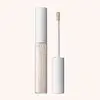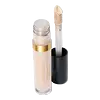What's inside
What's inside
 Key Ingredients
Key Ingredients

 Benefits
Benefits

 Concerns
Concerns

 Ingredients Side-by-side
Ingredients Side-by-side

Water
Skin ConditioningDimethicone
EmollientPolymethyl Methacrylate
Polymethylsilsesquioxane
Methyl Trimethicone
Skin ConditioningPEG-10 Dimethicone
Skin ConditioningGlycerin
HumectantButylene Glycol
HumectantAcrylates/Dimethicone Copolymer
Skin ConditioningSodium Potassium Aluminum Silicate
PEG/PPG-18/18 Dimethicone
EmulsifyingSodium Chloride
MaskingTrimethylsiloxysilicate
EmollientCaprylyl Dimethicone Ethoxy Glucoside
EmulsifyingDisteardimonium Hectorite
StabilisingTriethyl Citrate
MaskingSilica
AbrasiveDimethicone Crosspolymer
Emulsion StabilisingTriethoxycaprylylsilane
Tocopheryl Acetate
AntioxidantAluminum Hydroxide
EmollientDisodium EDTA
Bacillus/Soybean Ferment Extract
Skin ConditioningPhenoxyethanol
PreservativePotassium Sorbate
PreservativeSodium Dehydroacetate
PreservativeCI 77891
Cosmetic ColorantCI 77491
Cosmetic ColorantCI 77492
Cosmetic ColorantCI 77499
Cosmetic ColorantWater, Dimethicone, Polymethyl Methacrylate, Polymethylsilsesquioxane, Methyl Trimethicone, PEG-10 Dimethicone, Glycerin, Butylene Glycol, Acrylates/Dimethicone Copolymer, Sodium Potassium Aluminum Silicate, PEG/PPG-18/18 Dimethicone, Sodium Chloride, Trimethylsiloxysilicate, Caprylyl Dimethicone Ethoxy Glucoside, Disteardimonium Hectorite, Triethyl Citrate, Silica, Dimethicone Crosspolymer, Triethoxycaprylylsilane, Tocopheryl Acetate, Aluminum Hydroxide, Disodium EDTA, Bacillus/Soybean Ferment Extract, Phenoxyethanol, Potassium Sorbate, Sodium Dehydroacetate, CI 77891, CI 77491, CI 77492, CI 77499
Water
Skin ConditioningDimethicone
EmollientIsodecyl Neopentanoate
EmollientGlycerin
HumectantCetyl PEG/PPG-10/1 Dimethicone
EmulsifyingButylene Glycol
HumectantTrimethylsiloxysilicate
EmollientPolyglyceryl-4 Isostearate
EmulsifyingAcrylates/Polytrimethylsiloxymethacrylate Copolymer
Skin ConditioningAcrylates Copolymer
Propanediol
SolventAdipic Acid/Neopentyl Glycol Crosspolymer
Disteardimonium Hectorite
StabilisingDisodium Stearoyl Glutamate
CleansingPropylene Carbonate
SolventEthylene/Octene Copolymer
Ethylene/Sodium Acrylate Copolymer
Emulsion StabilisingXanthan Gum
EmulsifyingSodium Chloride
MaskingTocopheryl Acetate
AntioxidantAcmella Oleracea Extract
Skin Protecting1,2-Hexanediol
Skin ConditioningAluminum Hydroxide
EmollientDisodium EDTA
Tin Oxide
AbrasiveVp/Va Copolymer
Hydroxypropyl Methylcellulose
Emulsion StabilisingAmodimethicone
Caprylyl Glycol
EmollientChlorphenesin
AntimicrobialPhenoxyethanol
PreservativeSodium Dehydroacetate
PreservativePotassium Sorbate
PreservativeParfum
MaskingWater, Dimethicone, Isodecyl Neopentanoate, Glycerin, Cetyl PEG/PPG-10/1 Dimethicone, Butylene Glycol, Trimethylsiloxysilicate, Polyglyceryl-4 Isostearate, Acrylates/Polytrimethylsiloxymethacrylate Copolymer, Acrylates Copolymer, Propanediol, Adipic Acid/Neopentyl Glycol Crosspolymer, Disteardimonium Hectorite, Disodium Stearoyl Glutamate, Propylene Carbonate, Ethylene/Octene Copolymer, Ethylene/Sodium Acrylate Copolymer, Xanthan Gum, Sodium Chloride, Tocopheryl Acetate, Acmella Oleracea Extract, 1,2-Hexanediol, Aluminum Hydroxide, Disodium EDTA, Tin Oxide, Vp/Va Copolymer, Hydroxypropyl Methylcellulose, Amodimethicone, Caprylyl Glycol, Chlorphenesin, Phenoxyethanol, Sodium Dehydroacetate, Potassium Sorbate, Parfum
Ingredients Explained
These ingredients are found in both products.
Ingredients higher up in an ingredient list are typically present in a larger amount.
Aluminum Hydroxide is a form of aluminum. It can be naturally found in nature as the mineral gibbsite. In cosmetics, Aluminum Hydroxide is used as a colorant, pH adjuster, and absorbent.
As a colorant, Aluminum Hydroxide may add opacity, or reduce the transparency. Aluminum hydroxide is contains both basic and acidic properties.
According to manufacturers, this ingredient is an emollient and humectant. This means it helps hydrate the skin.
In medicine, this ingredient is used to help relieve heartburn and help heal ulcers.
There is currently no credible scientific evidence linking aluminum hydroxide in cosmetics to increased cancer risk.
Major health organizations allow the use of aluminum hydroxide in personal care products and have not flagged it as a carcinogenic risk at typical usage levels.
Learn more about Aluminum HydroxideButylene Glycol (or BG) is used within cosmetic products for a few different reasons:
Overall, Butylene Glycol is a safe and well-rounded ingredient that works well with other ingredients.
Though this ingredient works well with most skin types, some people with sensitive skin may experience a reaction such as allergic rashes, closed comedones, or itchiness.
Learn more about Butylene GlycolDimethicone is a type of synthetic silicone created from natural materials such as quartz.
What it does:
Dimethicone comes in different viscosities:
Depending on the viscosity, dimethicone has different properties.
Ingredients lists don't always show which type is used, so we recommend reaching out to the brand if you have questions about the viscosity.
This ingredient is unlikely to cause irritation because it does not get absorbed into skin. However, people with silicone allergies should be careful about using this ingredient.
Note: Dimethicone may contribute to pilling. This is because it is not oil or water soluble, so pilling may occur when layered with products. When mixed with heavy oils in a formula, the outcome is also quite greasy.
Learn more about DimethiconeDisodium EDTA plays a role in making products more stable by aiding other preservatives.
It is a chelating agent, meaning it neutralizes metal ions that may be found in a product.
Disodium EDTA is a salt of edetic acid and is found to be safe in cosmetic ingredients.
Learn more about Disodium EDTADisteardimonium Hectorite comes from the clay mineral named hectorite. It is used to add thickness to a product.
It can also help stabilize a product by helping to disperse other ingredients.
Hectorite is a rare, white clay mineral.
Learn more about Disteardimonium HectoriteGlycerin is already naturally found in your skin. It helps moisturize and protect your skin.
A study from 2016 found glycerin to be more effective as a humectant than AHAs and hyaluronic acid.
As a humectant, it helps the skin stay hydrated by pulling moisture to your skin. The low molecular weight of glycerin allows it to pull moisture into the deeper layers of your skin.
Hydrated skin improves your skin barrier; Your skin barrier helps protect against irritants and bacteria.
Glycerin has also been found to have antimicrobial and antiviral properties. Due to these properties, glycerin is often used in wound and burn treatments.
In cosmetics, glycerin is usually derived from plants such as soybean or palm. However, it can also be sourced from animals, such as tallow or animal fat.
This ingredient is organic, colorless, odorless, and non-toxic.
Glycerin is the name for this ingredient in American English. British English uses Glycerol/Glycerine.
Learn more about GlycerinPhenoxyethanol is a preservative that has germicide, antimicrobial, and aromatic properties. Studies show that phenoxyethanol can prevent microbial growth. By itself, it has a scent that is similar to that of a rose.
It's often used in formulations along with Caprylyl Glycol to preserve the shelf life of products.
Potassium Sorbate is a preservative used to prevent yeast and mold in products. It is commonly found in both cosmetic and food products.
This ingredient comes from potassium salt derived from sorbic acid. Sorbic acid is a natural antibiotic and effective against fungus.
Both potassium sorbate and sorbic acid can be found in baked goods, cheeses, dried meats, dried fruit, ice cream, pickles, wine, yogurt, and more.
You'll often find this ingredient used with other preservatives.
Learn more about Potassium SorbateChances are, you eat sodium chloride every day. Sodium Chloride is also known as table salt.
This ingredient has many purposes in skincare: thickener, emulsifier, and exfoliator.
You'll most likely find this ingredient in cleansers where it is used to create a gel-like texture. As an emulsifier, it also prevents ingredients from separating.
There is much debate on whether this ingredient is comedogenic. The short answer - comedogenic ratings don't tell the whole story. Learn more about comegodenic ratings here.
The concensus about this ingredient causing acne seems to be divided. Research is needed to understand if this ingredient does cause acne.
Scrubs may use salt as the primary exfoliating ingredient.
Learn more about Sodium ChlorideThis ingredient is a preservative with antimicrobial properties. It is the sodium salt of dehydroacetic acid.
It is especially effective at preventing bacterial and fungal growth in low concentrations.
Tocopheryl Acetate is AKA Vitamin E. It is an antioxidant and protects your skin from free radicals. Free radicals damage the skin by breaking down collagen.
One study found using Tocopheryl Acetate with Vitamin C decreased the number of sunburned cells.
Tocopheryl Acetate is commonly found in both skincare and dietary supplements.
Learn more about Tocopheryl AcetateThis silicone is an emollient. Emollients create a thin film on the skin to prevent moisture from escaping.
It is not soluble in water and helps increase water-resistance in products.
According to a manufacturer, it can blend seamlessly with silicone oils, such as Cyclopentasiloxane.
Learn more about TrimethylsiloxysilicateWater. It's the most common cosmetic ingredient of all. You'll usually see it at the top of ingredient lists, meaning that it makes up the largest part of the product.
So why is it so popular? Water most often acts as a solvent - this means that it helps dissolve other ingredients into the formulation.
You'll also recognize water as that liquid we all need to stay alive. If you see this, drink a glass of water. Stay hydrated!
Learn more about Water